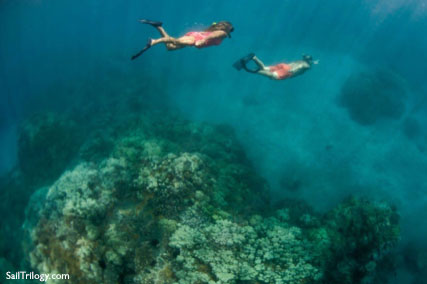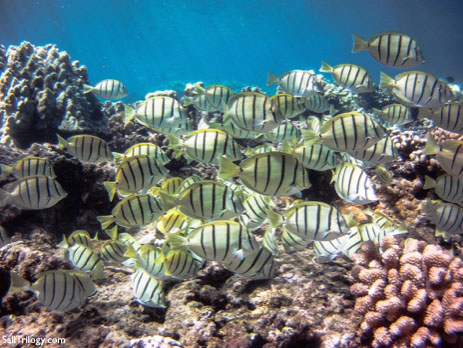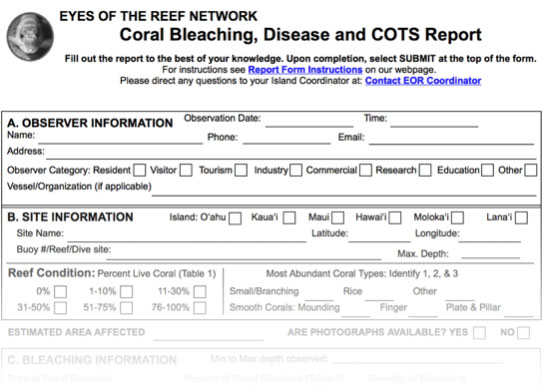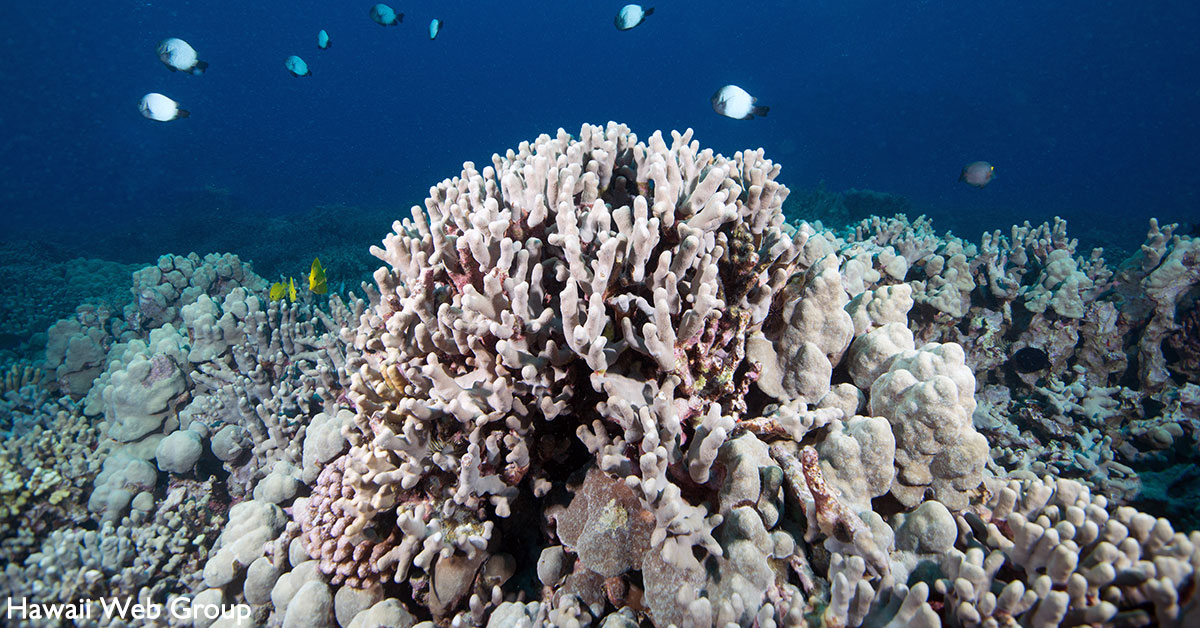Guest post by Kelly Montenero with Trilogy Excursions
Don’t get us wrong- Maui is still a beautiful, special place to snorkel, but, as any one who has entered the ocean recently can attest, there is a major environmental crisis underway. Hawai’i’s coral is bleaching at unprecedented levels due to warm ocean conditions- you may have spotted the snow white coral colonies at places you’re accustomed to seeing a rainbow of color on the reef. Want to know more? Check out these 5 important facts about coral bleaching and how it affects our reefs on Maui.
#1 Bleached coral is not dead coral.
Bleached coral is still alive and can recover. But, with recent sea surface temperatures 2 to 3 degrees Celsius higher than normal, if these conditions continue, coral mortality is likely. Coral is made up of living animals, and when it “bleaches”, the symbiotic algae that live within the coral animal (and give the coral its color) expel. This is detrimental to the coral since the symbiotic algae produce the majority of the coral animal’s food via photosynthesis. Coral can feed itself plankton it catches from the water column, but will eventually starve if the symbiotic algae do not return to the coral. The current report from the Division of Aquatic Resources estimates that 40-60% of corals in Maui County are bleaching or fully bleached currently.
#2 The current bleaching event is due to high ocean temperatures.
The symbiotic algae that produce food for coral leave the coral animal if environmental conditions are stressful, as they cannot tolerate high water temperatures. Due to climate change and global warming trends in our ocean on top of the current El Niño weather pattern, Hawai’i’s water temperatures are up to 2-3 degrees Celsius warmer than normal, as high as 30 C°. The bleaching threshold is usually 28 degrees Celsius for Hawaiian corals. If water temperatures decrease back to normal levels before too long, the symbiotic algae can return to the coral animals’ tissue and coral can recover from bleaching.
#3 Coral reefs are incredibly important to our ecosystem and our economy.
 Coral reefs are the “cities” of tropical seas, providing habitat and a food source for many animals. These animals in turn are a lower step on the food chain for larger fish, which people like to eat. Coral reefs also provide protection to Hawai’i shorelines by dissipating wave and storm energy. Finally, coral reefs provide a huge economic value for Hawai’i. The coral reefs of Hawai’i were estimated to provide more than $360 million/ year of direct economic benefits when accounting for recreational, amenity, fishery, and biodiversity values!
Coral reefs are the “cities” of tropical seas, providing habitat and a food source for many animals. These animals in turn are a lower step on the food chain for larger fish, which people like to eat. Coral reefs also provide protection to Hawai’i shorelines by dissipating wave and storm energy. Finally, coral reefs provide a huge economic value for Hawai’i. The coral reefs of Hawai’i were estimated to provide more than $360 million/ year of direct economic benefits when accounting for recreational, amenity, fishery, and biodiversity values!
#4 If stressors are removed, coral has a better chance of recovery.
 Local stressors include overfishing of herbivores, direct physical impact, such as trampling and anchor damage, and land based pollution such as sedimentation from shoreline development and runoff. These water conditions create a stressful environment for coral, so when other stressors are added, coral surpasses its tipping point. We can all do our part and reduce local stressors to give coral a chance.
Local stressors include overfishing of herbivores, direct physical impact, such as trampling and anchor damage, and land based pollution such as sedimentation from shoreline development and runoff. These water conditions create a stressful environment for coral, so when other stressors are added, coral surpasses its tipping point. We can all do our part and reduce local stressors to give coral a chance.
#5 Eyes of the Reef reporting by citizen scientists will result in identifying resilient reefs for future management decisions.
Feeling saddened by the widespread coral bleaching in Maui’s waters? Be a part of the solution and report the coral bleaching and paling you see to eorhawaii.org. This data is extremely important for state managers in order to best plan how to protect reefs that are able to bounce back. The Division of Aquatic Resources needs help from citizen scientists who snorkel in different locations on Maui. Attend an Eyes of the Reef training and learn how to report what you see. Or, come on a Trilogy Excursions snorkel trip– Trilogy staff are trained in the Eyes of the Reef program and can help you to identify bleaching and submit a report to EOR.


